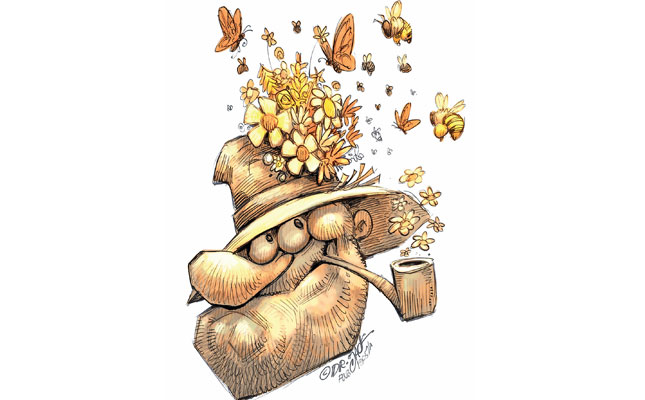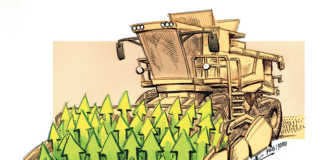
Three out of four crops across the globe that produce fruit or seed for human consumption depend, at least in part, on pollinators such as bees and birds.
Improving pollinator density and diversity boosts crop yields, as pollinators affect 35% of global agricultural land, supporting the production of 87 of the leading food crops worldwide.
Moreover, pollination-dependent crops are five times more valuable than those that do not need pollination. The price tag of global crops relying directly on pollinators is estimated at between US$235 billion (about R3,4 trillion) and US$577 billion (R8,3 trillion) a year.
Their quantity, too, is on the rise. The volume of agricultural production dependent on pollinators has increased 300% over the past 50 years.
These figures reflect the importance that pollinators have in sustaining livelihoods across the planet. Pollination is vital to life on Earth, and pollinators are essential to the production of many of the micronutrient-rich fruits, vegetables, nuts, seeds and oils we eat.
Several of the crops produced with pollination, including cocoa and coffee, provide an income for farmers, particularly smallholder farmers and family farms in developing countries.
In a sense, bees can also be considered as livestock. With the increasing commercial value of honey, bees are becoming a growing generator of income, livelihood strategy and means of food security for small-scale producers and forest dwellers in many developing countries.
Clearly, the benefits that bees and other small pollinators bring goes beyond human food.
Thanks to these pollinators, farm animals have diverse forage sources and hence more flexibility to adapt to an increasingly changing climate.
Decreasing numbers
Pollinators are currently under threat. But sustainable agriculture can reduce risk to them by helping to diversify the agricultural landscape and making use of ecological processes as part of food production.
Safeguarding bees also helps to safeguard biodiversity; the vast majority of pollinators, including more than 20 000 species of bees, are wild.
Present species extinction rates are 100 to 1 000 times higher than normal due to human impact. In all probability, insects will make up the bulk of future biodiversity loss, with 40% of invertebrate pollinator species, particularly bees and butterflies, facing extinction.
To a lesser degree, vertebrate pollinators (16,5%) are also threatened with extinction globally. Changes in land use and landscape structure, intensive agricultural practices, monocultures and use of pesticides have led to large-scale losses, fragmentation and degradation of their habitats.
Pests and diseases resulting from reduced resistance of bee colonies and from globalisation, which facilitates the transmission of pests and diseases over long distances, pose a special threat.
Climate change also has a negative impact: higher temperatures, droughts, floods and other extreme climate events, as well as changes in flowering times, hinder pollination, largely by desynchronising the demand (flowers in bloom) and the supply of service providers (abundant and diverse populations of pollinators).
While the diversity of available food is owed largely to animal pollinators, pollination services are showing declining trends in a number of regions. As farmlands have become larger, agricultural practices have changed, focusing on a narrower list of crops and increasing the use of pesticides.
Mounting evidence points to these factors as causes for the potentially serious decline in populations of pollinators. The decline is likely to affect the production and cost of fruits and vegetables, leading to increasingly unbalanced diets and health problems, such as malnutrition and non-communicable diseases.
Maintaining and increasing yields in horticultural crops under agricultural development is important to health, nutrition, food security and the income of smallholder farmers.
The process of securing effective pollinators to ‘service’ agricultural lands is proving difficult to engineer, and there is renewed interest in helping nature provide pollination services through practices that support wild pollinators.
The importance of farms
Natural habitats, forests and protected areas are usually thought to support greater biodiversity than neighbouring agro-ecosystems.
But this may not be the case with pollinators; under some management practices, their density and diversity can be even greater on farms than in adjacent wild areas.
For example, contrary to expectations, higher bee diversity was found in the open agricultural areas in western Kenya than in the nearby Kakamega Forest, one of the country’s most species-rich tropical rainforests.
The bee fauna in the farms surrounding Kakamega Forest may be less threatened by human factors. After crops are harvested, the land is left fallow until the next season, enhancing the growth of herbs and shrubs, which provide rich food sources for bees.
In addition, farmers close to the forest do not overuse chemicals such as fungicides, insecticides and herbicides. With improved pollination management, crop yields could be further increased by about 25%.
By ensuring higher yields and successful agricultural production, pollinators would contribute significantly to world food security and nutrition for a growing global population, while ending poverty and hunger.
So, well-managed farms can provide good habitats for bees, who, in turn, provide pollination services for agricultural production.
Protecting bees
To protect bees and pollinators from the threats to their abundance, diversity and health, efforts should be made to build a greater diversity of pollinator habitats in agricultural and urban settings.
Policies in favour of pollinators that promote biological pest control and limit the use of pesticides should be implemented.
Farmers can help maintain pollinator abundance, diversity and health by using innovative practices that integrate local and scientific knowledge and experience, and by diversifying farms to make food resources and shelter continuously available to pollinators.
We need to increase collaboration among national and international organisations, academic and research bodies and networks to monitor, research and assess pollinators and pollination services.
The views expressed in our weekly opinion piece do not necessarily reflect those of Farmer’s Weekly.
This report was produced by the Food and Agriculture Organization of the United Nations.











